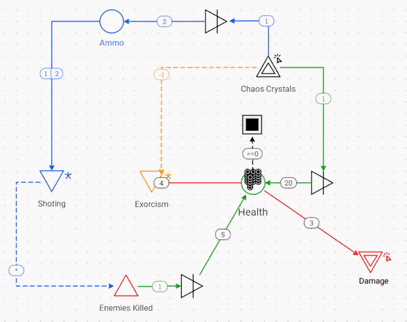
Exorcism
Game Designer
Hectic Bite-Sized Twin Stick Shooter, where player life is constantly depleted at an increasing rate. Keep killing enemies and changing weapons to survive as things become more hectic and time alive less.
Project Info
Genre: Arcade Twin Stick Shooter
Project Type: Solo
Timeline: 8 Weeks - 2023
Engine: Unreal Engine 5
Designed & Implemented
A Core Gameplay Loop strongly intertwined with the Combat Dynamics & Meta-Progressions.
Meta-Progression, reinforcing a Bite-Sized player experience & player retention.
Tightly knit Combat Dynamics targeted at a self-reinforcing loop.
Adjusted Game Systems & Balance Coop Adaptation.
3 Enemies, fulfilling different roles & design intentions.
Onboarding, UI/UX, Audio-Visual Communication…
Core Loop
Note: "Chaos Crystals" is the in-game term
used for the randomized weapon crates.
What
I produced the initial concept for a Twin Stick Shooter game, that merges Super Crate Box’s randomized weapons and arcade-like structure with the continuous action and health drain from Post Void, in a hectic and bite-sized format.
The player constantly loses health. This is caused and scaled by a resource called “Exorcism”. This serves as a difficulty scaler, which also influences enemy spawning.
Killing enemies restores health but consumes limited ammo.
Kills in rapid succession reduce Exorcism slightly.
Weapon Crates provide a random weapon with full ammo while restoring health and increasing Exorcism.
The player performs 3 main Verbs: Shoot, Move, Dash.
Actions are kept simple to allow players to focus on positioning and moment-to-moment decision-making.
How
I started with research, followed by creating a prototype in machination, breaking down the concept, and validating the loop for a rapid prototype implementation. This was followed by iteration through playtesting.
Machination has been a key tool to support the development of the core loop. It enabled me to visualize issues and connections within the tightly intertwined resource loop before the in-engine implementation, making iteration more nimble and time-effective.
It also served as a platform to test out the balancing and tuning of the systems, thanks to a clear visualization of the flow of resources.
Why
Player Experience:
Hectic: The player should constantly be on their toes and be required to make split-second decisions.
Bite-Sized: A round should not last more than 3 minutes, while still providing a meaningful experience to the player.
The ever-depleting health system and all the interactions around it build a sense of insecurity and short-term objectives that create hectic game states where quick thinking is the only tool for a successful outcome.
The difficulty scaling and progression are reminiscent of the balancing of classic arcade games, keeping the interaction loops concise and delivering the experience in a bite-sized format where the mechanics shine.
Combat Dynamics & Coop Adaptation
Combat Dynamics
Coop Adaptation
Overview
I adapted the game mode and designed & implemented player-to-player interactions to account for two-player local coop.
Spawn rates of enemies and maximum enemies alive are slightly increased to balance out combat flow, accounting for the two-player killing rate.
Players share one Exorcism Meter, which increases the overall difficulty; this is partially offset due to both players engaging in individual Hot-Streaks, reducing the Exorcism Meter.
Furthermore, the number of Weapon Crates is not increased to reinforce positional cooperation, communication, and cooperation through task delegation.
Players are respawned after the remaining player collects 3 Weapon Crates. The threat of “staying alive indefinitely” is off-balanced by the increased health depletion this results in.
Due to nearly every aspect of the game demo being tightly intertwined, simulating the game in machinations was crucial to test and balance. It provided a readable and holistic view of variables while allowing for rapid iteration and testing.
What
Combat Dynamics, leveraging core gameplay systems, and 3 enemy types I designed with distinct roles to achieve increasing difficulty and reinforce the self-feeding loop, aimed to accomplish the player experience.
How
The constant health depletion encourages killing enemies to restore health. Therefore, players use their limited ammunition, pushing them to pick up the next weapon crate to continue their killing spree, which in turn increases the Exorcism Meter, speeding up the rate at which health is depleted. Contrasting quick consecutive kills reduce the Ecorcism Meter through the kill Hot-Streak System.
Different Exorcism thresholds determine what enemy types are used and their spawn chances.
Why
The difficulty progression is tied to the Exorcism Meter, which is at the center of the core loop. Mastery is the driving force to surviving longer (your score), as play is optimized, thus better Exorcism management, which encourages active play through the Hot-Streak System.
The three enemies fulfill the roles of “Fodder”, effectively a small area of denial through melee attacks, the “Priest”, a high-priority target able to exorcise the player, and the “Archangel”, an enemy introducing additional complexity and requiring to be “focused down” to kill.
The primary goal was to make the center combat focused on positioning and increasingly quicker decisions that are the focal point for difficulty progression.
Meta Progression
What
Meta Progression centered around a scoreboard system, and the bite-sized sessions reinforced by the core loop.
How
Playtesting informed the iteration goal, to further align the game demo with the desired player experience and project goals. I utilized research as a foundation for concepting the iteration.
I used design intentions and theoretical models to guide choosing the most effective approach to the iteration goal, to improve short & long-term player retention.
Why
Based on the Self Determination Theory (PENS model), the scoreboard functions as a performance tracker that rewards mastery, providing room for competence, while the leaderboard serves as a ground for relatedness (PENS), encouraging interaction between players.
Going both directions, the system reinforces, supports, and complements the core gameplay loop and combat dynamics to achieve the intended player experience.
Afterthoughts
PENS defines the third important aspect for long-term player retention to be autonomy.
During the 8-week project duration, I did not have the opportunity to explore this within the context of the game, however I believe that a good starting point would be providing players with some agency over their playstyle and other rogue-lite progression systems such as Quality of Life unlocks to improve future attempts at a new highscore.
This being said, this also poses a risk as it provides indirectly a competitive handicap to new players, diluting mastery with player progression.
Prelude
As developers, we wanted to highlight and leverage the strengths of our custom engine, which led us to create a survivor-type game. The initial design draft was guided by reference research (the primary reference was 20 Minutes Till Dawn).
Using reference research and target audience research, we defined our target player experience (pillars) and guidelines.
A key challenge that we faced was a tight & unforgiving 8-week production schedule, as we needed to develop the demo game in parallel to creating engine features & tools.
Limiting the scope, avoiding bottlenecks, and being risk-averse were essential to the success of the project.
Player Combat - Weapons & Upgrades
Combat Framework
What
Designed a flexible and scalable core combat/weapon system that supports unique weapon mechanics, supports iteration for the design team, and allows for future expansion through upgrades.
How
By analysis of combat, upgrades, and effects in reference games, I created a document listing potential weapon variables (e.g., attack speed), events (e.g., on-hit), and functionalities (e.g., damage over time).
We narrowed it down based on the first weapon draft, design priorities, and technical feasibility.
Along with a breakdown of the weapon framework and information on what needs to be exposed to the design team, this was used to communicate the system and its capabilities to the programmers.
Why
Given the tight schedule, we needed a flexible system that allowed the design team to experiment and iterate with weapons and future upgrades, without major refactoring or delays.
I produced the initial concept for a Twin Stick Shooter game, that merges Super Crate Box’s randomized weapons and arcade-like structure with the continuous action and health drain from Post Void, in a hectic and bite-sized format.
Weapons
What
3 Weapons, targeting different playstyles and player groups.
Gif of uninterrupted gameplay
The player constantly loses health. This is caused and scaled by a resource called “Exorcism”. This serves as a difficulty scaler, which also influences enemy spawning.
Killing enemies restores health but consumes limited ammo.
Kills in rapid succession reduce Exorcism slightly.
Weapon Crates provide a random weapon with full ammo while restoring health and increasing Exorcism.
Zubek / Onion / Types of Fun
*Chaos Crystals is the name given to the Weapon Crates.
{Talk about strongly intertwined loop?}
Early Design Breakdowns
Do the Work
The player performs 3 main Verbs: Shoot, Move, Dash.
Actions are kept simple to allow players to focus on positioning and moment-to-moment decision-making.
How
I started with research, followed by creating a prototype in machination, breaking down the concept, and validating the loop for a rapid prototype implementation.
Gif of Early prototype
Early In-Engine Prototype
Machination has been a key tool to support the development of the core loop. It enabled me to visualize issues and connections within the tightly intertwined resource loop before the in-engine implementation, making iteration more nimble and time-effective.
It also served as a platform to test out the balancing and tuning of the systems, thanks to a clear visualization of the flow of resources.
Replace “Chaos Crystals” with “Weapon Crate”
Why
Player Experience
Hectic:
The player should constantly be on their toes, and be required to make split-second decisions.
Bite-Sized:
A round should not last more than 3 minutes, while still providing a meaningful experience to the player.
Kinds of Fun
Following the “8 Kinds of Fun,” these elements facilitated enjoyment:
- Challenge
- Sensation
- Fellowship
I used this to help understand the player’s motivation and narrow down the audience which provides a clearer picture of how “fun” is going to be delivered.
This helps as an additional guide for design decisions and prioritization.
The ever-depleting health system and all the interactions around it build a sense of insecurity and short-term objectives that create hectic game states where quick thinking is the only tool for a successful outcome.
Hectic Gameplay Gif
The difficulty scaling and progression are reminiscent of the balancing of classic arcade games, keeping the interaction loops concise and delivering the experience in a bite-sized format where the mechanics shine.
Hectic Gameplay Gif
Section Title (H1)
What/Why/How (Sub Title) (H2)
Standard Text (P2)
Tiny Title (H4)
Section Title (H1)
What/Why/How (Sub Title) (H2)
Standard Text (P2)




